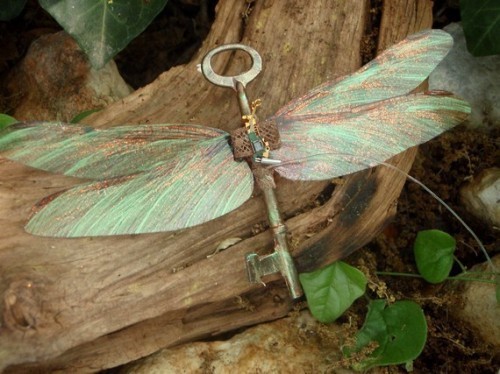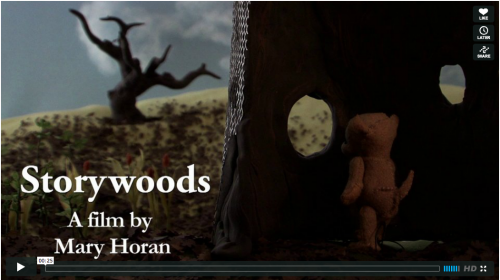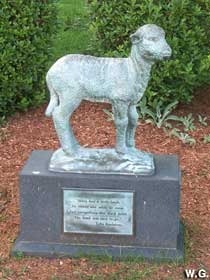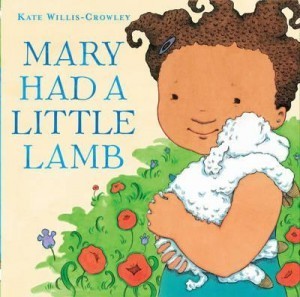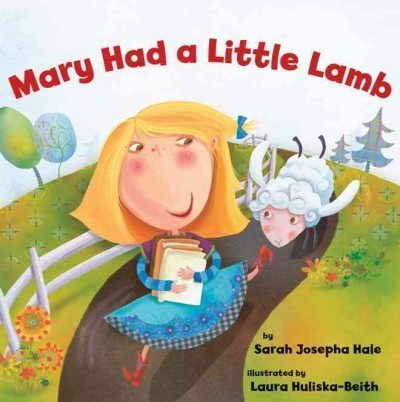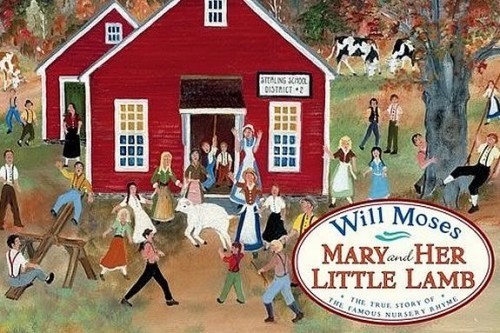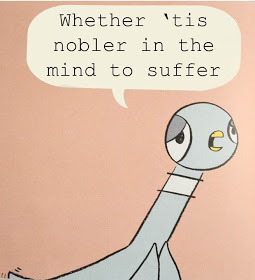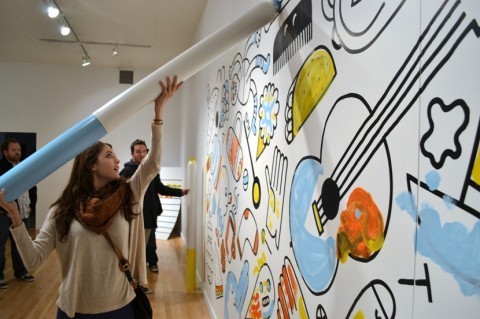Betsy Bird's Blog, page 318
February 22, 2013
Fusenews: Harumphing my amens
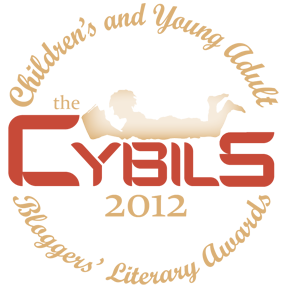 Not sure how long I’ll get to keep calling my little news items “Fusenews” since the Fuse network, hitherto not a problem in my sphere, has just decided to call their news program, you guessed it, Fuse News. But really, who am I to complain? It’s a kicky little term.
Not sure how long I’ll get to keep calling my little news items “Fusenews” since the Fuse network, hitherto not a problem in my sphere, has just decided to call their news program, you guessed it, Fuse News. But really, who am I to complain? It’s a kicky little term.
So! The 2012 Cybils Awards were handed out just the other day and the winners are sublime. Kudos particularly to Sadie and Ratz by Sonya Hartness (winner of the Early Chapter Book category), Giants Beware by Jorge Aguirre (winner of the Middle Grade Graphic Novel category), The False Prince by Jennifer A. Nielsen (winner of the Middle Grade Fantasy & Science Fiction category), Wonder by R.J. Palacio (winner of the Middle Grade Chapter Book category), and Friends With Boys by Faith Erin Hicks (winner of the Young Adult Graphic Novel category and Best Book I Didn’t Review in 2012).
Marjorie Ingall’s on the ball, reviewing a rare picture book with a Jewish theme AND gay parents. As she says, “it’s about time”. Sometimes it seems to me that it’s particularly hard for a book for kids to be two things at once. Jewish AND gay. Black AND dealing with a dead pet. Korean AND deaf. It’s like children’s literature requires one category and if you double or triple it then no one knows how to define you. The Purim Superhero is obviously not the first picture book with Jewish gay parents but the rarity is undeniable.
Here in town there’s a l’il ole theater called the New Victory. And from time to time they’ve a habit of putting on theatrical productions for children. Actually it’s all the time, and they’re a HUGE theater in the center of Times Square. In any case, the nice folks in that neck of the woods often like me to come up with reading lists as companions for their shows. Right now they’re presenting a character famous in picture books in Australia but not particularly well known here. As a result I created some Grug (that’s his name) readalikes. Love that stuff, I do!
I like this next one because rather than do a long write-up I can just lift the helpful little JPG o’ info:
This would be the Facebook Page referenced above: https://www.facebook.com/byjanbrett. Right now Bloomsburg, PA is in the lead. You gonna take that sitting down, o rest of the country?
In movie news, John Rocco’s Caldecott Honor winning picture book Blackout was just optioned film rights-wise and may be a live action feature film. They’re actually having script meetings n’ all. Well done, John!
All right. The title of today’s Fusenews is a response to this piece. This is the post I’ve been waiting for all along. Mainly, an independent bookseller’s response to the news that Barnes & Noble will be closing some of their locations. At long last Josie Leavitt of the ShelfTalker blog tackles the thorny issue. Josie’s post, as you will see, has gotten a couple fiery responses, but far fewer than I expected.
In other news, there are three things I like about the TeachingBooks.net site right now. First off, there’s the fact that they’re now presenting a range of audio interviews conducted with the most recent winners of the ALA Youth Media Awards. That’s cool. Then there’s the fact that they have provided up-to-date photos of each of those winners. Suddenly I’m fascinated. So THAT is what Ethan Long looks like! You actually cannot find this kind of information much of anywhere. And third, I love that they’re including the winners of the Canadian awards as well as the American ones. International love!
Daily Image:
Isn’t the world just a slightly happier place now that you know that winged keys really do exist?
Thanks to Crooked House for the image.
February 21, 2013
The Niblings Arrive: A Children’s Literature Supergroup for All Your Children’s Literary Needs
 Think of it like Voltron. Or, better yet, don’t.
Think of it like Voltron. Or, better yet, don’t.
If you are a clever daily blog reader and you have already seen the posts at Seven Impossible Things Before Breakfast, Nine Kinds of Pie, and 100 Scope Notes then what I’m about to tell you will come as no surprise. To wit:
The Niblings is a new blog consortium, over at Facbeook and Twitter, representing Seven Impossible Things Before Breakfast (Jules Danielson), A Fuse #8 Production (this guy), Nine Kinds of Pie (Philip Nel), and 100 Scope Notes (Travis Jonker).
We considered calling this page “100 Notes on Why 7 8 9,” but it sounded too much like a math page. And when Philip Nel suggested “The Niblings,” we all fell hard for it.
Our goal with this group is to share — in one convenient location — links from our blogs, as well as other interesting links related to the field of children’s literature. Instead of us sharing links to our respective blogs on four separate pages, consider this (the Facebook page or Twitter feed) a one-stop resource center for information on children’s literature. This was initially Jules’ very smart idea and she clearly couldn’t pass up the fun numerology in these four blog titles. Can you blame her? So in short:
The Niblings is on Facebook at www.facebook.com/TheNiblings
And we’re on Twitter at www.twitter.com/TheNiblings4
Whence the name? Well, “The Niblings” comes from Tove Jansson’s Moomin series:
“Do you like educational games?” Hodgkins asked cautiously.
“I love them!” said the Nibling.
I sat down and didn’t know what to say.
— Tove Jannson, final chapter of Moominpappa’s Memoirs (1968, revision of The Exploits of Moominpappa, 1950), translated by Thomas Warburton, p. 147
Why this name for our group?
Tove Jansson’s Niblings love educational games and are, of course, often hungry. And we four children’s-lit bloggers have a comparably rapacious curiosity.
It is the nature of blogs to take small bites of things. Niblings like to gnaw on things, too. (Niblings also chew off noses they think are too long. We vow not to do this.)
“Niblings” is a term for nieces or nephews and thus offers an additional link to young readers.
The word evokes other literary groups, such as the Inklings (C.S. Lewis, J.R.R. Tolkien, et al), as well as Fanny Burney’s 1779 play The Witlings (which satirizes the literary world).
It’s slightly absurd, rather like Monty Python, Moxy Fruvous, Boing Boing (the blog), or, let’s face it, A Fuse #8 Production (which, if we’re going to get technical about it, was named after a car part).
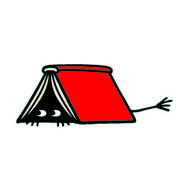 We hope you enjoy our consortium over there in Facebook Land, should you be a Facebook-user.
We hope you enjoy our consortium over there in Facebook Land, should you be a Facebook-user.
The Niblings art here was created by the great Megan Montague Cash and is © 2013 The Niblings (Betsy Bird, Julie Danielson, Travis Jonker, Philip Nel).
February 19, 2013
Review of the Day: Hank Finds an Egg by Rebecca Dudley
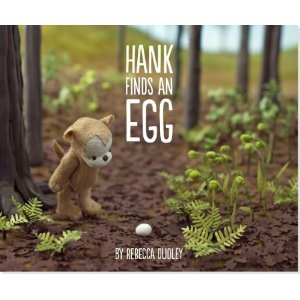 Hank Finds an Egg
Hank Finds an Egg
By Rebecca Dudley
Peter Pauper Press, Inc.
$16.99
ISBN: 978-1-4413-1158-0
Ages 3-7
On shelves May 1st
Photography in children’s literature holds a real fascination for me. No work of pure photography has ever won a Caldecott Award or Honor and, when it comes right down to it, there are only two ways to even make a picture book for children with photos. Either you set up animals or people in tableaus and write stories/poems around them (Photoshop has aided in this process, though not significantly improved upon it) or you use models. If you go the model route you then have to be artistically talented in not one but two areas of expertise. You see where this is going. Most great artists who make models for picture books eschew using photography’s strengths, relying entirely on their art. And most photographers who make picture books care more about their shots than the artwork or the characters they’re shooting on an aesthetic level. The perfect medium only comes when you either have a fantastic model artist and a fantastic photographer working in tandem or, rarest of all, a fantastic model artist who doubles as a fantastic photographer. All this is just a roundabout way of saying that this is why a book like Hanks Finds an Egg works as well as it does. Calling herself “a builder, creator, photographer, and artist”, newcomer Rebecca Dudley tells a fine tale without a single solitary word.
The first shot in this book is precisely what you’ll see on the cover. A little bear (I think he’s a bear, though his tail is admittedly a bit long) finds an abandoned egg sitting in the middle of the path. A quick scan of the surrounding area reveals the corresponding nest, though it is very high above the ground. Hank attempts several methods at returning the egg but each time he tries he finds he’s just too short. Bowed but not beaten (and with the mama bird nowhere in sight) he takes the egg to his campsite and keeps it warm throughout the night. The next morning he returns to the scene of the crime to find a mama hummingbird there and anxious for her baby’s return. Fortunately a spot of inspiration hits Hank and the next thing you know he’s come up with the perfect plan for getting that little egg back into its nest once and for all.
Hank Finds an Egg began its life as a self-published title called “Hank Finds an Egg and Makes Several Friends”. Peter Pauper Press wisely made the decision to pare the title down to its essentials, and was in the unique position of not having to heavily edit the text as well. If Hank Finds an Egg works it is because it doesn’t have a single word to its name. Would that more self-published authors went this very wise route. By letting the pictures alone tell the story, Rebecca Dudley gives her reading audience some very much needed credit. The joy of wordless books has always been the fact that no matter what the child’s reading level, with purely graphic storytelling they are able to finally “read” a book on their own without feeling dumb. I’ve heard of teachers using wordless picture books with new immigrants who do not yet speak the language, and with kids who love books but struggle with reading disabilities. Hank has an allure not simply because Dudley has a keen eye for panels and storytelling, but because the images she includes also happen to be beautiful from start to finish.
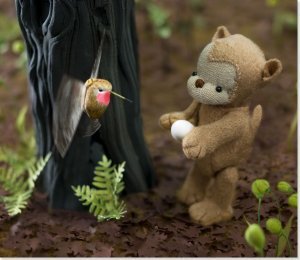 One cannot speak of photographed models and, more to the point, bears, without invoking the most infamous picture book of them all: The Lonely Doll. Created by photographer Dare Wright, the Lonely Doll books are sometimes remembered today for their dated reliance on spanking as a method of control (the poor doll’s frilly underpants not helping matters any). While it’s easy to scoff at the questionable morals of the books, let us not forget that there was one area in which they excelled. Photographer Dare Wright was able to create a truly memorable series through the strength not just of the bear and doll models but also her own photography. The Lonely Doll is at times breathtakingly beautiful. There is a shot, for example, of the doll and bear standing at the end of the Brooklyn Bridge, no human in sight, that would be worthy of framing and placing on your wall, if you were so inclined to do so.
One cannot speak of photographed models and, more to the point, bears, without invoking the most infamous picture book of them all: The Lonely Doll. Created by photographer Dare Wright, the Lonely Doll books are sometimes remembered today for their dated reliance on spanking as a method of control (the poor doll’s frilly underpants not helping matters any). While it’s easy to scoff at the questionable morals of the books, let us not forget that there was one area in which they excelled. Photographer Dare Wright was able to create a truly memorable series through the strength not just of the bear and doll models but also her own photography. The Lonely Doll is at times breathtakingly beautiful. There is a shot, for example, of the doll and bear standing at the end of the Brooklyn Bridge, no human in sight, that would be worthy of framing and placing on your wall, if you were so inclined to do so.
Wright was either hampered or helped by her reliance on black and white photography. Dudley isn’t restricted in this way, but she’s clever enough not to go bold and brassy with her color palette. Since this is a woodland tale the primary tones are browns and greens. Against this dull backdrop the white of the egg stands out brilliantly. Later the ruby throats of the hummingbirds are, with the exception of the pink flowers that brighten up Hank’s campsite, the only spots of reddish hue to be found in the book’s pages. As you go through the book, take time to notice when Dudley keep the focus on an object near the camera or far away. Like a graphic novelist, she takes great care to switch camera angles from one moment to the next. The book doesn’t have the static a + b + c narrative that would bog down a lesser artist. There’s tension in how she sets up her shots, and a flow to the gentle, never saccharine, storytelling.
As for the models themselves, Dudley has a tendency to create vast dioramas made out of what I can only assume to be felt. Hank, for his part, is so clearly constructed that you can make out the very stitches holding him together. Then there are the visual tricks that give the tale its pep. A campfire a little later skillfully recreates the feeling of fire partly by somehow bouncing light from the campsite into Hank’s face. And then there’s the clever way in which Dudley gives the impression of movement with the hummingbird’s moving wings. Blurred fibers (even examining the pictures again and again I’m not sure how she did this) make it look as though parts of the hummingbird are moving at a speed that cannot be captured by the eye. If it’s a gimmick it’s a clever one, and (more to the point) one that serves the story well.
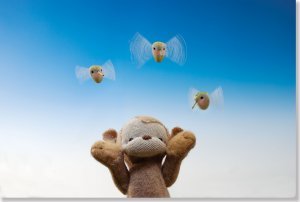 One should probably note that it would be wise to explain to kids that what Hank does in this book is not par for the course. If a child should find that an egg has fallen from a nest, the best thing would NOT be to try to return it on their own. On the visual side of things, there is a somewhat odd moment when the newly hatched hummingbirds sit in their nest and appear to glare down at Hank. Clearly that is not the story’s intent, and yet I’m sure there will be more than a few kids who ask why the baby hummingbirds are so angry and their savior. And I’m sure someone somewhere will find it dubious that hummingbird eggs could be as large as the ones featured here. That point doesn’t really bother me all that much.
One should probably note that it would be wise to explain to kids that what Hank does in this book is not par for the course. If a child should find that an egg has fallen from a nest, the best thing would NOT be to try to return it on their own. On the visual side of things, there is a somewhat odd moment when the newly hatched hummingbirds sit in their nest and appear to glare down at Hank. Clearly that is not the story’s intent, and yet I’m sure there will be more than a few kids who ask why the baby hummingbirds are so angry and their savior. And I’m sure someone somewhere will find it dubious that hummingbird eggs could be as large as the ones featured here. That point doesn’t really bother me all that much.
Weigh the strengths against the weaknesses and you still come to find that Hank Finds an Egg is an honestly touching story told with a unique format that resembles few picture books being churned out today. Because here’s the crazy fact that no one ever considers: kids love photographs. They do. And they love picture books made up of photographs. The fact that we see so few of these in a given year may have as much to do with the range of artistic skills that need to be employed as it does big publishers’ reluctance to take a chance on a medium that doesn’t tend to win awards. Sometimes you have to leave the creativity to the little guys. And few little guys are quite as appealing to old Hank here. It’s something special, no question.
On shelves May 1st.
Like This? Then Try:
The Lonely Doll by Dare Wright
Here Comes the Garbage Barge by Jonah Winter, ill. Red Nose Studio
The Princess and the Pea by Lauren Child
Stardines Swim Across the Sky by Jack Prelutsky, ill. Carin Berger
Other Blog Reviews:
Dad of Divas’ Reviews
Misc:
Publishers Weekly discusses the book as well as the publisher and their new forays into the realm of children’s books.
For further steps into Hank’s world, do check out Ms. Dudley’s blog Storywoods.
Video:
And on a related note, here is a short film trailer for the aforementioned Storywoods:
February 17, 2013
Nursery Rhyme Investigation: Mary Had a Little Lamb
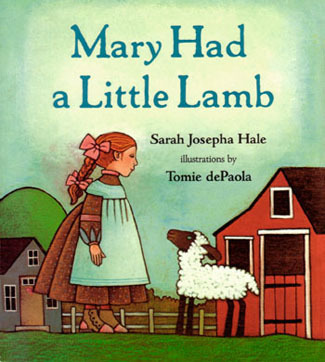 It was the shock of my lifetime to discover that kids really do dig nursery rhymes. To be a bit more specific about it, my kid in particular. Here she was, not even a year and a half old, and suddenly she could not get enough of those collections by Tomie dePaola and Arnold Lobel. And it all started with a lamb. A little one at that.
It was the shock of my lifetime to discover that kids really do dig nursery rhymes. To be a bit more specific about it, my kid in particular. Here she was, not even a year and a half old, and suddenly she could not get enough of those collections by Tomie dePaola and Arnold Lobel. And it all started with a lamb. A little one at that.
I’d received the Tomie dePaola board book of Mary Had a Little Lamb in the great Molly donation of 2011. It’s signed by Mr. dePaola himself and if I were a practical woman I’d probably mount it and hang it in some fashion on my wall. Instead, I allowed my grubby, grimy, adorable spawn to paw through it. No gnawing. I drew the line there. But if she wanted to read it (and she seemed to) all power to her.
After I sang the book to her the first time she was enthralled. Seriously, nothing like this book had ever enraptured her. I’d sort of assumed that the 19th century setting and subtle palette would not appeal to her baby brain. So wrong was I. I then started to experiment. I brought home other Mary Had a Little Lamb titles. Each time I did the kiddo delighted. She’d compare pictures, their similarities and differences. She got her own little white lamb stuffed animal and would carry it with her when the books were read. This all culminated to the point where when we visited a downtown Kalamazoo city creche this past Christmastime, it was the plaster lambs that were the hit of the day. She’s sheep crazy, this kid.
 So it all got me to thinking: Whence Mary? Whence that little lamb? And how do different picture books of the duo stack up in the long run?
So it all got me to thinking: Whence Mary? Whence that little lamb? And how do different picture books of the duo stack up in the long run?
First stop, I picked up my copy of Albert Jack’s Pop Goes the Weasel: The Secret Meanings of Nursery Rhymes. Truth be told, I’ve grown wary of this resource. It sometimes seems to come up with more theories than facts, but on the subject of Mary it was loquacious. There was admittedly some speculation as to whether or not the poem was written as a kind of Christian homily. You know. Mary. The lamb. The true origins of the poem come from one Sarah Josepha Hale who, depending on whom you ask, submitted the poem to Dr. Lowell Mason when he asked writers to contribute songs and rhymes for the Boston school system. It was a big time hit from the start. Some speculation arose as to whether or not the poem was written by Hale or by a John Roulstone instead and whether or not there really was a Mary and a lamb. Whatever the case, it was fun to learn that in Sterling, Mass. there’s a statue of the lamb in the town center.
Awww.
Back to the book that started this all. I found that Tomie dePaola wrote an extensive piece online about this book, as well as why he chose it, and the fact that he found he added fuel to the fire when he credited the poem to Sarah Josepha Hale and not Mr. Roulstone. Reading Mr. dePaola’s funny and well-researched piece I realized all too late who Sarah was.
Do these titles ring any bells?
Yup! Sarah was the same Sarah who we credit today with the holiday of Thanksgiving. Geez oh marie, the woman was busy.
Then I started looking at other picture book editions of the poem. Granted, I was limited to in print versions available through my library system. Still, my library system is NYPL, and that ain’t small bananas.
First up, my favorite version, and an import at that:
Mary Had a Little Lamb by Kate Willis-Crowley
This is a British import so you won’t find that many copies floating around the States at the moment. If you do find some, they’re worth discovering. First off, it’s the only multicultural Mary I could find. Second, she’s very adventuresome. Usually when you get the “everywhere that Mary went the lamb was sure to go” line Mary is sleeping or walking benignly somewhere. In this book Mary has just become a modern day Alice, following a rabbit burrow up top again, while the poor lamb muddles through the dark tunnel after her. The book is shorter in its verses than most, cutting out the part where the lamb rests its head on Mary’s arm or kids are instructed to bind animals gently, but it’s still fun. Particularly when you take into account how harrowed that poor teacher is. She truly does look to be at her wits end. There’s a rather bizarre Silence of the Lambs moment at the end where we see Mary wearing a paper plate lamb face that looks just eerie, but beyond that the story is keen from start to finish.
Next, a book that isn’t afraid to go full-text.
Mary Had a Little Lamb, illustrated by Laura Huliska-Beith
Like dePaola, she credits Hale as the author. Unlike him she includes a note at the end discussing the poem’s origins. This pairs very well with the Willis-Crowley version and is actually one of the more playful Marys out there. The lamb is the only one I’ve seen where, ejected from the school, he “lingers near” by sitting, morose, on a swing set, eyeing the doors of the school. The most colorful version of the story I know.
Mary Had a Little Lamb by Sara Varon as found in Nursery Rhyme Comics
Varon’s style and storytelling are on full display with this one. The colors are a bit more muted than I’d like but you can’t help but love the fact that this is the only lamb who actually follows Mary to school with the hopes of getting its own education (note the jaunty backpack and the fact that it snaps up a seat in class).
None of these are to be confused with
Mary and Her Little Lamb by Will Moses
Subtitled “The True Story Behind the Nursery Rhyme” Moses goes where few authors have dared and not only brings the “real” story to live but credits Roulstone as the author! And the debate rages and rages on. The kiddo liked this one mostly because she adores the Will Moses nursery rhymes book and also because this one included a lot of barns. She likes barns right now.
Any others you’d think were worth mentioning? Lay ‘em on me. I’d love to add to her repertoire.
February 15, 2013
Review of the Day – Diego Rivera: An Artist for the People by Susan Goldman Rubin
 Diego Rivera: An Artist for the People
Diego Rivera: An Artist for the People
By Susan Goldman Rubin
Abrams Books for Young Readers
$21.95
ISBN: 978-0-8109-8411-0
Ages 10 and up
On shelves now
National Hispanic Heritage Month runs from September 15th to October 15th. How many folks could tell you that off the top of their heads? Meanwhile, few awards are specifically earmarked for nonfiction books for children with Latino themes. There have, however, been quite a few articles in the popular news about the lack of books for children with Hispanic characters in them. So what about biographies of famous Hispanics? Surely those must be abundant in some way. The funny thing is that you can find bios for children of such fabulous folks as Tito Puente, Frida Kahlo, Celia Cruz, Sonia Sotomayor, and others. The catch? They tend to be picture book biographies. Get a little older and the only bios you can find are those dull as dishwater ones that tell a person’s statistics without getting within twenty paces of the person’s heart and soul. Dull boring affairs. I mention all this to point out how bloody rare a book like Susan Goldman Rubin’s biography Diego Rivera: An Artist for the People really is. This isn’t one of those bios that flaunts its Timeline and reads like it was written in a monotone. There is life to these pages, and breadth to its subject. Short enough to reward a wary reader but with enough context and clarity to bring Diego to life, Rubin takes a tricky guy for kids to know about and makes him precisely what he was: bigger than life.
From the very moment Diego could clutch a pencil his chubby little hands he was drawing. A boy with a natural talent, he was able to convince his parents to let him attend prep school during the day and the San Carlos Academy of Fine Arts at night. As he grew more skill he learned, as everyone did at that time, from the European school of draftsmanship. It was only after he began to notice the works of street artists like Jose Guadalupe Posada that Diego recognized that European styles were not enough. He needed a style and a medium for the people. His people! As a muralist he was able to fulfill those very passions. Rubin tracks not just Diego’s life and commissions but also his thought process and where he heart lay as an artist. Full-color photographs complement the text. Backmatter includes a note about Mexico’s history, a note on Rivera’s influences, a listing of where to find his art, a Glossary of terms and names, Source Notes, Bibliography, and an Index.
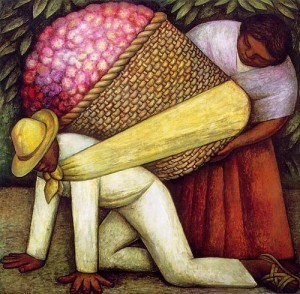 My knowledge of South America in general has been coming in fits and starts over the years thanks to a smattering of films, television programs, and children’s books. It makes for an eclectic education, to say the least. And I have learned a thing or two about Mexican history, but if I’m completely honest most of it came from Before Columbus: The Americas of 1491 by Charles C. Mann. This isn’t as crazy a comparison as you might think since one of the nice things about Diego Rivera is Ms. Rubin’s willingness to delve a bit into that same pre-Columbus history. In the back of the book you will find “A Note About the History of Mexico, As Referenced in Rivera’s Artwork.” If the premise of the book is that Diego could not be who he was without a thorough knowledge of his own country’s history then it stands to reason that kids should have access to an abbreviated form of that same knowledge.
My knowledge of South America in general has been coming in fits and starts over the years thanks to a smattering of films, television programs, and children’s books. It makes for an eclectic education, to say the least. And I have learned a thing or two about Mexican history, but if I’m completely honest most of it came from Before Columbus: The Americas of 1491 by Charles C. Mann. This isn’t as crazy a comparison as you might think since one of the nice things about Diego Rivera is Ms. Rubin’s willingness to delve a bit into that same pre-Columbus history. In the back of the book you will find “A Note About the History of Mexico, As Referenced in Rivera’s Artwork.” If the premise of the book is that Diego could not be who he was without a thorough knowledge of his own country’s history then it stands to reason that kids should have access to an abbreviated form of that same knowledge.
There’s a term my husband likes to pull out when we see a nice trim film that’s no longer than it needs to be: “handsome”. As in, “That was a nice handsome film.” I’d go so far as to apply that term to books as well. Take Diego Rivera here. Now this is a nice handsome biography. Plenty of chapters and backmatter and all that jazz, but at the same time it’s a svelte 56 pages. Less than 100. I love that. I admit that it’s not always ideal, since there are lazy teachers in this world who will tell kids to read something over 100 pages for a class assignment (if one were feeling particularly snarky they’d point out that the most recent Captain Underpants title is 192 pages). Those that take the time to look at the books their kids read, however, will find in this book a bit of a godsend. It’s long enough that it can offer a kid a pretty vast swath of its subject’s life, but not so huge that they’ll be intimidated by it. The size is akin to that of a picture book or a coffee table book. It’s a comfortable size for a handsome volume.
A small page count does mean that the author has to decide how much to say about a person. In that, Ms. Rubin has taken care to hit on the highlights, always making sure to show that Diego worked with an eye to the people. She gives more than adequate attention to the murals and what they meant to the poor as well as Diego’s ties to causes he believed in. She’s just as willing to show when he lied about those alliances too, as when he claimed to play a part in the revolt against Porfirio Diaz. By the same token, you see him hobnobbing with rich nobs and if you’re discussing this book with kids you could ask them such pertinent questions as whether or not they feel that Diego’s ties to the rich and influential hurt his credibility or if it cemented him as famous and is why he’s remembered today.
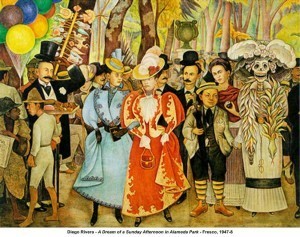 This all begs the obvious question: What the heck do you do with Mr. Rivera’s . . . ah . . . wandering eye, shall we say? The problem with writing about an artist who delved in drugs is how much to say. The problem with a lothario is pretty much an identical quandary. Rubin engages in the breezy, “He had always liked the ladies, and the ladies had always liked him,” following it up with a sly, “despite his bulk and his habit of rarely taking a bath.” In this way she limits herself to just reporting on those affairs Diego conducted that affected his various marriages and engagements. Those that didn’t are simply left unsaid. No one will miss them.
This all begs the obvious question: What the heck do you do with Mr. Rivera’s . . . ah . . . wandering eye, shall we say? The problem with writing about an artist who delved in drugs is how much to say. The problem with a lothario is pretty much an identical quandary. Rubin engages in the breezy, “He had always liked the ladies, and the ladies had always liked him,” following it up with a sly, “despite his bulk and his habit of rarely taking a bath.” In this way she limits herself to just reporting on those affairs Diego conducted that affected his various marriages and engagements. Those that didn’t are simply left unsaid. No one will miss them.
Considering the sheer number of ladies the man slept with, it’s funny to me that books about him for kids really have mostly stayed in the 4-8 year-old range until now. There was Diego Rivera: His World and Ours by Duncan Tonatiuh, Diego: Bigger Than Life by Carmen Bernier-Grand, and Diego by Jonah Winter. My Papa Diego and Me written by Diego’s daughter Guadalupe Rivera Marin was a rare exception of a chapter book on the man, and even that skewed a bit young. With her book Rubin at last gives us a chapter book biography that does credit to the artist himself. Respecting her audience to show Diego’s flaws as well as his triumphs, consider this nuanced portrait of a man every schoolchild should know. Worthy of its subject matter.
On shelves now.
Source: Final copy sent from publicist for review.
Like This? Then Try:
My Papa Diego and Me by Guadalupe Rivera Marin
Chuck Close: Face Book by Chuck Close
Before Columbus: The Americas of 1491 by Charles C. Mann
Other Blog Reviews:
proseandkahn
Professional Reviews:
Kirkus
Misc:
Finally, I have a hard time thinking of Diego’s affairs without also thinking of this fabulous Hark, A Vagrant! comic piece. It’s the last on the page.
February 14, 2013
Press Release Fun: Diversity and the State of the Children’s Book
Boy, I love it when I set up a Literary Salon months in advance and then the universe conspires to make it even more timely than I’d initially intended. Expect this next one at the main branch of NYPL to feature one hot and toasty little panel talk. I shall mentally prepare in the interim.
New York Public Library’s Children’s Literary Salon is pleased to announce our next event on Saturday, March 2nd at 2:00 p.m.
Diversity and the State of the Children’s Book
Join authors Zetta Elliott (Ship of Souls, Bird), Sofia Quintero (Efrain’s Secret, Divas Don’t Yield), Connie Hsu (editor, Little Brown) and others for an honest conversation about the issues surrounding diversity in 21st century books for youth.
This event will be held in the Schwarzman Building (42nd Street & 5th Avenue a.k.a. the one with the lions) in the Berger Forum on the second floor.More information found here.
February 12, 2013
Fusenews: Though wouldn’t you rather read “Bertie & Psmith”?
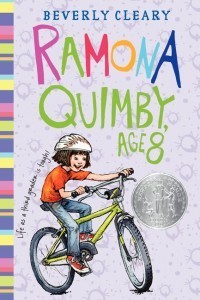 Before we begin I would like to have a few words with the publishers on behalf of catalogers nationwide.
Before we begin I would like to have a few words with the publishers on behalf of catalogers nationwide.
Ahem.
Hi, guys. How’s it going? Heckuva weird weather we’ve had lately, right? Yeah . . . so . . . here’s the thing. You know how you’ve been rereleasing a couple classic children’s books recently like Slake’s Limbo and all the Ramona Quimby books? That is just awesome of you. Seriously, new covers were desperately needed. But, you’re kind of doing this weird thing that’s messing everything up. See, for some reason you’re changing the covers but you’re keeping the old ISBNs. And we wouldn’t really mind if it was just the jackets you were changing, but in the case of the Ramona books you have new interior illustrations. This is a HUGE disservice, not only to libraries, but to your new illustrator, Ms. Jacqueline Rogers. If you keep the same ISBN then in records across the country previous illustrators will be listed in the system. Not Ms. Rogers. So, I know we’re supposedly going to go through some crazy crisis where we run out of all the ISBNs, but do a gal a favor and change the ISBNs on rereleases if you have new interior art (or, also in the case of Ramona, new pagination). It just makes good clean sense.
Okay! Moving on.
If I say that Travis Jonker fellow at 100 Scope Notes is a nice guy I’m not exactly telling you anything you don’t already know. But how nice is he? Well, in his awesome 10 to Note: Spring Preview 2013 do you know what book he led with? MINE!! I’m thrilled and flabbergasted all at once. Ye gods! I hit the big time, folks! Now I just need to get my hands on that cool looking Lauren Myracle early chapter book and that new Charise Mericle Harper graphic novel. Woot!
You know you’re cool when the National Coalition Against Censorship collects cool birthday wishes for you. You’re even cooler if those birthday wishes come from folks like Jon Scieszka, Lois Lowry, and the aforementioned Lauren Myracle. And if you happen to be Judy Blume? Icing on the cake, baby.
On the one hand, it’s awfully interesting to hear folks speculating on what really made Mary Ingalls blind. On the other hand . . . . NBC News linked to me, linked to me, linked to me me me!
In case you happened to missed it, I hosted a helluva Literary Salon the other day. Yup. Jeanne Birdsall, Adam Gidwitz, N.D. Wilson, and Rebecca Stead all gave up their precious time to stop by old NYPL for a Children’s Literary Salon where they debated why pop culture at large tries to label middle grade fiction as YA. The whole conversation was, for the very first time, recorded for posterity. That’s the good news. The bad news is that the audio feed is lousy. Not sure what I did but it’s a bit mucked up. Clear enough that you could make a transcript from it (casts meaningful looks into the nethersphere) but not so clear that you could actually enjoy listening to it. A little later in the podcast some folks stop speaking into mics. That actually helps. Rear in Gear reports on how it went from the frontlines. By the way, the title “Why YA” is a good one. I might shorten it to Y.YA, then proclaim that to be the newest bestest trend without explanation. Cause that’s how I roll.
Speaking of my Children’s Literary Salons, I’ve one in early March on the topic of Diversity and the State of the Children’s Book that will prove to be most fascinating (and better recorded, I hope). Much along the same lines is a truly fascinating post over at Ms. Yingling Reads. The post concerns those book jackets that do not reflect the ethnicity of the characters within, but brings up a very interesting p.o.v. from that of the smaller publisher reliant on stock images. This post is your required reading of the day. Many many thanks to Carl in Charlotte for the heads up.
The post on 10 Fictional Libraries I’d Love to Visit is a lot of fun, but I would add the library featured in Neil Gaiman’s Sandman books most certainly. That would be the library that contains every book conceived of but never published by the world’s greatest writers. The in-jokes alone are worth it. Who doesn’t love Psmith and Jeeves?
Thanks to AL Direct for the link.
Nerd that I am, I cannot help but be thrilled that the Bologna Book Fair has just established a new prize for the Best Children’s Publisher of the Year. What a fantastic idea, and why has no one else come up with it before? Now THAT is something I can get behind. Boy, yeah.
Flavorwire’s Conspiracy Theories About Classic Literary Characters doesn’t tell you a lot you haven’t already heard about your classic books (Nick Carraway = gay, Holden Caulfield = gay, yadda yadda yadda) but there are some fun exceptions on the children’s literature side. I think I’ve heard the Winnie-the-Pooh theory before, and I certainly heard the Harry Potter one (Rowling herself even addressed it) but the Wizard of Oz one is actually entirely a new one on me. Huh! Thanks to Annie Cardi for the link.
I like it when authors reveal the covers of their upcoming books. I especially like it when those authors are folks I’ve heard of before and have enjoyed thoroughly. I met Matthew Kirby (The Clockwork Three, Icefall) at a SCBWI event recently and now I find out that he has revealed his latest title The Lost Kingdom. Yep. I’ll be reading that one.
The other day I spoke on a panel for some young publishers about the library’s role in the pursuit of Common Core. I was on that panel with Scottie Bowditch of Penguin and John Mason of Scholastic. After the fact I learned that Scholastic has been working to get their hands on all this Common Core schtuf by creating the site Common Sense for the Common Core. It was created to help parents through this tricky time, but no doubt we librarians would benefit a tad as well. FYI!
You may have heard that tornadoes recently ripped through Mississippi on Sunday causing untold devastation in their wake. They hit in a number of places, including Hattiesburg, Mississippi. Why do I mention this? Well, are you aware what resides in Hattiesburg? That would be the University of Southern Mississippi. And what is the University of Southern Mississippi home to? If you answered that it was the de Grummond Collection “one of North America’s leading research centers in the field of children’s literature” you would also be correct. So did the collection survive the storms? We are happy to report that they did. And on the de Grummond’s Twitter feed they assured everyone that they were safe and sound. Whew!
Look me in the eye. Right here! Right in my beady little eye and tell me that this is not the smartest use of The Pigeon you’ve seen in a long long time. The crazy thing? I thought they melded together a bunch of different Pigeon books. Not true! Instead, all these panels come from The Pigeon Wants a Puppy.
Remember when NPR started that program they called NPR’s Backseat Book Club? They said they would pick a new book for kids every month and discuss them. Well, the whole “every month” part of that plan has been spotty and the selections have been even spottier. Seems to me NPR isn’t taking full advantage of the field. I mean, Black Beauty and Wimpy Kid? Is that the best you can do? Fortunately it looks like they’ll crank things up a notch when they discuss Gary Schmidt’s Okay for Now . In fact, kids are encouraged to submit some questions to the author ahead of time. Got yourself some kids? Then go to it!
Speaking of kids submitting stuff, you may have heard that YA author Ned Vizzini is getting into the middle grade fiction arena. He isn’t doing it alone, though. Director Chris Columbus is penning House of Secrets with him. Aside from the fact that the book has an honest-to-god blurb from J.K. Rowling on it (no blurb whore she) kids can get a copy by tweeting Ned their “secrets”. You can see some examples here. Love the kid who used to eat chocolate dog biscuits. That one I believe.
Would you like $1000? Sure. We all would. But to be a bit more specific, would you like $1000 for your program that uses, “children’s literature as a way to promote international understanding”? Well then are you in luck! USBBY would sure like to give you some cash. Say they, “Schools, libraries, scout troops, clubs and bookstores are all eligible for this award. Does your school or library program or do you know of another organization that “promotes reading as a way to expand a child’s world”? To learn more about the award, view information about past winners and award criteria and access the downloadable application form, please link to: http://www.usbby.org/list_b2u.html“
Done and done.I wasn’t particularly aggrieved by the Anne of Green Gables brou-de-haha going on about that random cover someone created. In fact, a commenter at ShelfTalker with my name (not me, alas) basically summarized my thoughts on the matter brilliantly when she said, “Folks, you are getting all upset because you MISUNDERSTAND the situation. This is NOT a ‘PUBLISHER’ with a marketing dept. This is a public domain book that some RANDOM PERSON is selling. You could do the same thing. PUBLIC DOMAIN – it means anyone can do anything with it. Here is a list of public domain books: http://www.feedbooks.com/publicdomain. If you want, you yourself could publish, say, Les Miserables by Victor Hugo with a photo on the cover of Governor Chris Christie eating a donut. (If you had the rights to the donut picture of course.)” Which was all well and good . . . but I truly have to tip my hat to Donytop5 who simply replied, “Here Betsy, I found it! http://wolverinesss.tumblr.com/image/42556986881“ That made my day, right there.
Apparently there’s a competitor to Goodreads out there and it’s calling itself Bookish. It’s not really the same thing as Goodreads, mind you, since it’s publisher driven through and through. Says Media Decoder, “Instead of relying essentially on the taste of other customers with similar preferences, as most recommendation engines do, Bookish’s tool takes into account critical reviews and awards.” Curious, I decided to see what they had in the realm of children’s literature. It’s interesting. Not a ton of content yet, but their recommendations aren’t shabby. Worth eyeing warily for a while.
Daily Image:
Someday I will be very rich and I will create a children’s library of my very own. When I do, I will allow one or two walls to be like this:
Fortunately if that looks cool to you, you don’t have to wait. Just head on over to the Indianapolis Museum of Contemporary Art and have your fun. Thanks to Swiss Miss for the link!
February 11, 2013
Fusenews: Though wouldn’t you rather read “Bertie & Psmith”?
 Before we begin I would like to have a few words with the publishers on behalf of catalogers nationwide.
Before we begin I would like to have a few words with the publishers on behalf of catalogers nationwide.
Ahem.
Hi, guys. How’s it going? Heckuva weird weather we’ve had lately, right? Yeah . . . so . . . here’s the thing. You know how you’ve been rereleasing a couple classic children’s books recently like Slake’s Limbo and all the Ramona Quimby books? That is just awesome of you. Seriously, new covers were desperately needed. But, you’re kind of doing this weird thing that’s messing everything up. See, for some reason you’re changing the covers but you’re keeping the old ISBNs. And we wouldn’t really mind if it was just the jackets you were changing, but in the case of the Ramona books you have new interior illustrations. This is a HUGE disservice, not only to libraries, but to your new illustrator, Ms. Jacqueline Rogers. If you keep the same ISBN then in records across the country previous illustrators will be listed in the system. Not Ms. Rogers. So, I know we’re supposedly going to go through some crazy crisis where we run out of all the ISBNs, but do a gal a favor and change the ISBNs on rereleases if you have new interior art (or, also in the case of Ramona, new pagination). It just makes good clean sense.
Okay! Moving on.
If I say that Travis Jonker fellow at 100 Scope Notes is a nice guy I’m not exactly telling you anything you don’t already know. But how nice is he? Well, in his awesome 10 to Note: Spring Preview 2013 do you know what book he led with? MINE!! I’m thrilled and flabbergasted all at once. Ye gods! I hit the big time, folks! Now I just need to get my hands on that cool looking Lauren Myracle early chapter book and that new Charise Mericle Harper graphic novel. Woot!
You know you’re cool when the National Coalition Against Censorship collects cool birthday wishes for you. You’re even cooler if those birthday wishes come from folks like Jon Scieszka, Lois Lowry, and the aforementioned Lauren Myracle. And if you happen to be Judy Blume? Icing on the cake, baby.
On the one hand, it’s awfully interesting to hear folks speculating on what really made Mary Ingalls blind. On the other hand . . . . NBC News linked to me, linked to me, linked to me me me!
In case you happened to missed it, I hosted a helluva Literary Salon the other day. Yup. Jeanne Birdsall, Adam Gidwitz, N.D. Wilson, and Rebecca Stead all gave up their precious time to stop by old NYPL for a Children’s Literary Salon where they debated why pop culture at large tries to label middle grade fiction as YA. The whole conversation was, for the very first time, recorded for posterity. That’s the good news. The bad news is that the audio feed is lousy. Not sure what I did but it’s a bit mucked up. Clear enough that you could make a transcript from it (casts meaningful looks into the nethersphere) but not so clear that you could actually enjoy listening to it. A little later in the podcast some folks stop speaking into mics. That actually helps. Rear in Gear reports on how it went from the frontlines. By the way, the title “Why YA” is a good one. I might shorten it to Y.YA, then proclaim that to be the newest bestest trend without explanation. Cause that’s how I roll.
Speaking of my Children’s Literary Salons, I’ve one in early March on the topic of Diversity and the State of the Children’s Book that will prove to be most fascinating (and better recorded, I hope). Much along the same lines is a truly fascinating post over at Ms. Yingling Reads. The post concerns those book jackets that do not reflect the ethnicity of the characters within, but brings up a very interesting p.o.v. from that of the smaller publisher reliant on stock images. This post is your required reading of the day. Many many thanks to Carl in Charlotte for the heads up.
The post on 10 Fictional Libraries I’d Love to Visit is a lot of fun, but I would add the library featured in Neil Gaiman’s Sandman books most certainly. That would be the library that contains every book conceived of but never published by the world’s greatest writers. The in-jokes alone are worth it. Who doesn’t love Psmith and Jeeves?
Thanks to AL Direct for the link.
Nerd that I am, I cannot help but be thrilled that the Bologna Book Fair has just established a new prize for the Best Children’s Publisher of the Year. What a fantastic idea, and why has no one else come up with it before? Now THAT is something I can get behind. Boy, yeah.
Flavorwire’s Conspiracy Theories About Classic Literary Characters doesn’t tell you a lot you haven’t already heard about your classic books (Nick Carraway = gay, Holden Caulfield = gay, yadda yadda yadda) but there are some fun exceptions on the children’s literature side. I think I’ve heard the Winnie-the-Pooh theory before, and I certainly heard the Harry Potter one (Rowling herself even addressed it) but the Wizard of Oz one is actually entirely a new one on me. Huh! Thanks to Annie Cardi for the link.
I like it when authors reveal the covers of their upcoming books. I especially like it when those authors are folks I’ve heard of before and have enjoyed thoroughly. I met Matthew Kirby (The Clockwork Three, Icefall) at a SCBWI event recently and now I find out that he has revealed his latest title The Lost Kingdom. Yep. I’ll be reading that one.
The other day I spoke on a panel for some young publishers about the library’s role in the pursuit of Common Core. I was on that panel with Scottie Bowditch of Penguin and John Mason of Scholastic. After the fact I learned that Scholastic has been working to get their hands on all this Common Core schtuf by creating the site Common Sense for the Common Core. It was created to help parents through this tricky time, but no doubt we librarians would benefit a tad as well. FYI!
You may have heard that tornadoes recently ripped through Mississippi on Sunday causing untold devastation in their wake. They hit in a number of places, including Hattiesburg, Mississippi. Why do I mention this? Well, are you aware what resides in Hattiesburg? That would be the University of Southern Mississippi. And what is the University of Southern Mississippi home to? If you answered that it was the de Grummond Collection “one of North America’s leading research centers in the field of children’s literature” you would also be correct. So did the collection survive the storms? We are happy to report that they did. And on the de Grummond’s Twitter feed they assured everyone that they were safe and sound. Whew!
Look me in the eye. Right here! Right in my beady little eye and tell me that this is not the smartest use of The Pigeon you’ve seen in a long long time. The crazy thing? I thought they melded together a bunch of different Pigeon books. Not true! Instead, all these panels come from The Pigeon Wants a Puppy.
Remember when NPR started that program they called NPR’s Backseat Book Club? They said they would pick a new book for kids every month and discuss them. Well, the whole “every month” part of that plan has been spotty and the selections have been even spottier. Seems to me NPR isn’t taking full advantage of the field. I mean, Black Beauty and Wimpy Kid? Is that the best you can do? Fortunately it looks like they’ll crank things up a notch when they discuss Gary Schmidt’s Okay for Now . In fact, kids are encouraged to submit some questions to the author ahead of time. Got yourself some kids? Then go to it!
Speaking of kids submitting stuff, you may have heard that YA author Ned Vizzini is getting into the middle grade fiction arena. He isn’t doing it alone, though. Director Chris Columbus is penning House of Secrets with him. Aside from the fact that the book has an honest-to-god blurb from J.K. Rowling on it (no blurb whore she) kids can get a copy by tweeting Ned their “secrets”. You can see some examples here. Love the kid who used to eat chocolate dog biscuits. That one I believe.
Would you like $1000? Sure. We all would. But to be a bit more specific, would you like $1000 for your program that uses, “children’s literature as a way to promote international understanding”? Well then are you in luck! USBBY would sure like to give you some cash. Say they, “Schools, libraries, scout troops, clubs and bookstores are all eligible for this award. Does your school or library program or do you know of another organization that “promotes reading as a way to expand a child’s world”? To learn more about the award, view information about past winners and award criteria and access the downloadable application form, please link to: http://www.usbby.org/list_b2u.html“
Done and done.I wasn’t particularly aggrieved by the Anne of Green Gables brou-de-haha going on about that random cover someone created. In fact, a commenter at ShelfTalker with my name (not me, alas) basically summarized my thoughts on the matter brilliantly when she said, “Folks, you are getting all upset because you MISUNDERSTAND the situation. This is NOT a ‘PUBLISHER’ with a marketing dept. This is a public domain book that some RANDOM PERSON is selling. You could do the same thing. PUBLIC DOMAIN – it means anyone can do anything with it. Here is a list of public domain books: http://www.feedbooks.com/publicdomain. If you want, you yourself could publish, say, Les Miserables by Victor Hugo with a photo on the cover of Governor Chris Christie eating a donut. (If you had the rights to the donut picture of course.)” Which was all well and good . . . but I truly have to tip my hat to Donytop5 who simply replied, “Here Betsy, I found it! http://wolverinesss.tumblr.com/image/42556986881“ That made my day, right there.
Apparently there’s a competitor to Goodreads out there and it’s calling itself Bookish. It’s not really the same thing as Goodreads, mind you, since it’s publisher driven through and through. Says Media Decoder, “Instead of relying essentially on the taste of other customers with similar preferences, as most recommendation engines do, Bookish’s tool takes into account critical reviews and awards.” Curious, I decided to see what they had in the realm of children’s literature. It’s interesting. Not a ton of content yet, but their recommendations aren’t shabby. Worth eyeing warily for a while.
Daily Image:
Someday I will be very rich and I will create a children’s library of my very own. When I do, I will allow one or two walls to be like this:
Fortunately if that looks cool to you, you don’t have to wait. Just head on over to the Indianapolis Museum of Contemporary Art and have your fun. Thanks to Swiss Miss for the link!
Review of the Day: One Came Home by Amy Timberlake
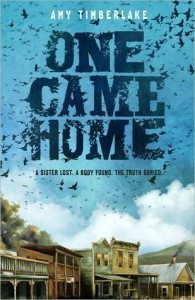 One Came Home
One Came Home
By Amy Timberlake
$16.99
ISBN: 978-0-375-86925-9
Ages 10 and up
On shelves now
I like children’s books that sock you in the gut. Not the books that telegraph their hits or do the old one-two punch you can see coming from a mile away. No way, man, I’m talking about the books where you’re reading along, merrily as you please, and then this hammer of a hit comes in from out of the blue and just hocks the wind right out of you. Middle grade fiction, also known as chapter book fiction for kids, can sometimes feel like one long unending stream of samey sameness. Then you get a whiff of something like One Came Home and it does you a world of good. Kids need a little variety. If they’re going to read historical fiction (and they are) then why not give them bloody interesting historical fiction for once? Something with gunplay and counterfeiting and true affection between sisters and gowns and all that stuff? A mystery and quest tale all at once, Timberlake’s latest lifts her from the masses of samey same middle grade onto another level. And kid readers end up the winners.
Agatha is dead, to begin with. Or is she? When the sheriff came home with a body in a ball gown with its features blown all to smithereens (or eaten by wild animals) everyone in Placid, Wisconsin believes that it’s Georgie’s older sister. The one that ran off after Georgie helped to spoil her engagement. Georgie, for the record, doesn’t believe a word of it and she’s going to find the truth. As far as she’s concerned Agatha just has to be alive somewhere, so with a local boy, a mule, some gold coins sewn into her hems, and a gun she can rely on, Georgie sets off to prove her theory. Trouble is, the truth ends up being a whole lot more complicated than she ever could have suspected.
You know, I liked Amy Timberlake when I read her That Girl Lucy Moon back in 2006. That book was a contemporary novel about a girl trying to buck the system in her own particular way. Like Norma Rae with sledding. What it didn’t do was allow Ms. Timberlake to indulge in a character’s voice. Lucy Moon was pleasant and all, but when you left the book you didn’t find her stuck in your head for long periods of time. Georgie has that over Lucy then. She’s the kind of gal who likes to make an impression, even if that means hanging around your grey matter. I don’t regularly wrestle with the mad desire to read a book aloud but somewhere around page 83 I had to stifle an impromptu recitation on the #7 subway train.
Now there is a True Grit feel to the book that is impossible to deny. Not merely because of the can-do attitude of the heroine with her straightforward methods and ahead-of-its-time gumption, but also because the book reads as if the events had taken place long ago in the past. Timberlake adeptly alternates between perspective and the emotions of a 13-year-old barely entering adolescence. Not that this is the first True Grit-ish middle grade I’ve seen since the release of the Cohen Brothers film of the same name. The Case of the Deadly Desperados by Caroline Lawrence would actually make a sterling companion to One Came Home. Both books involve a mystery and a protagonist with hidden skills in the 1800s West. [By the way, another reader pointed out that the book bears more than a few similarities to [book: Atonement] and where is the line drawn between homage and borrowing? An interesting point.]
In Georgie, Timberlake finds a voice prone to particularly beautiful passages. And if you believe that this book consists of the remembrances of a grown woman looking back then it is easier to accept lines like, “But those images of bells and streams dissolved, and all I saw was a wind stirred by the evil winged creatures from Pandora’s box.” Or, on the next page, “… there’s a difference between feathers and leaves. Feathers claw their way back into the sky, whereas leaves, after flying once, are content to rest on the earth. Agatha? She was a feather.” Later still, “I froze. My body did, anyway. My mind, on the other hand, jumped over the moon and ran off with the spoon.” And finally, “You don’t turn the color of dust unless you’re returning to it.” That’s just a small sample, but it’s a hint of what I mean.
I always thought that passenger pigeons were small. When we talked about them in school, usually in the context of extinct American animals, I pictured birds the size of the pigeons you see in cities today. In point of fact they were “as big as crows” and your average everyday 21st century American citizen really doesn’t know all that much about them. I know that I, for one, did not know about the vast swarms of pigeons that would pass by, yielding a disgusting sleet of bird poop beneath. The sheer history packed into this little book is far beyond mere tales of bird excrement, though. Timberlake has a tendency to spoonfeed her readers history alongside pertinent background information. It’s as if we’d choke if she didn’t get it out in piecemeal. This is not a criticism, mind you, merely an observation. She is quite adept at giving the reader believable and relatable period details that feel right for the time. For example, we learn that Georgie finished her sixth year of winter school the year before and thought it would be fun but in the winter, “no schoolwork made the dark hours endless.” Tell me a kid can’t get behind that.
Now certainly there are passages here that defy credulity. Georgie’s prowess with a gun takes on near superhuman attributes later on in the story, and there may be a danger that this plunges some readers out of the story. I didn’t particularly mind. I like my superheroes, particularly those of the 13-year-old female persuasion. And I very much like those girls who, when given a chance to kill another person, do not do so because their very doubt in God stays their itchy trigger finger. There is also an almost superfluous last chapter to the book that could potentially come right out. It sets the book in history nicely but feels like it comes after all the actions of the characters have been resolved (not to give anything away). Then there is the resolution to whether or not Agatha is truly dead. The answer comes in such a way where it appears that nothing Georgie has done has led to the answer. Dig a little deeper, though, and I think that you could argue that Georgie’s actions did, inadvertently anyway, move the book towards its ultimate resolution (this not giving anything away business is hard going, no?). Finally, there is a very good question as to why no one wonders why the body of Agatha was found wearing a ball gown. That important point isn’t raised by even Georgie at the beginning. Seems a bit of a slip for our proto-detective. Young ladies were not prone for traipsing about the wilderness in green/blue velvet, after all.
So will kids dig it? Some will. Depends on how they come to it. Though my inclination would be to booktalk it to them on the murder mystery solving, if you do that then they might get turned off by the sweeter sister interactions at the start. Best if you inform them straight out that it’s a book about two sisters who love one another very much until one ends up dead in a ditch and the other doesn’t believe in the body. A good honest hook is all this title really needs to get some interest. And I’ve just gotta believe that a kid with a canny ear will pick up on everything Timberlake’s doing. Hopefully anyway. It’s a smart little book that does a small misstep from time to time but ultimately ends up being one of the most gripping little novels you’ll come across. Smart and funny and not something a kid with a yen is likely to put down, it’s a funky little number. Hope to see more books of the past like it in the future.
For ages 10 and up.
Source: Galley sent from publisher for review.
First Sentences: “So it comes to this, I remember thinking on Wednesday, June 7, 1871. The date sticks in my mind because it was the day of my sister’s first funeral and I knew it wasn’t her last – which is why I left. That’s the long and short of it.”
Like This? Then Try:
The Case of the Deadly Desperados by Caroline Lawrence
Hattie Big Sky by Kirby Larson
The Misadventures of Maude March by Audrey Couloumbis
Three Times Lucky by Sheila Turnage
Other Blog Reviews:
crossreferencing
The O.W.L.
Waking Brain Cells,
Professional Reviews:
A star from School Library Journal
A star from Kirkus
The Washington Post,
Interviews: I Read Banned Books
Misc:
Download the discussion guide here.
Fellow author Karen Cushman’s also a fan.
And finally, Timberlake discusses her influences and research.
February 9, 2013
Video Sunday: Know what you know
So apparently in the 1980s the Brooklyn Public Library decided to take a page out of the Reading Rainbow handbook and came up with this series of kids recommending books that they loved. The result, so nicely posted on the Hairpin, will pretty much keep you amused all the livelong day. You just gotta wonder where these kids are today, of if they’re aware this stuff is out there.
Now it is a very rare thing to see comedian John Hodgman speaking seriously, but it does happen from time to time. But he is entirely serious here and his advice quite good. That is, if you can tear yourself away from his yellow lenses long enough to take in what he’s talking about.
Thanks to Annie Cardi for the link.
Last weekend I hosted Jeanne Birdsall, N.D. Wilson, Rebecca Stead, and Adam Gidwitz in a Literary Salon at NYPL. Alas, no video recording was made, though there is a rather scratchy audio file that is worth it if you stick with it in spite of the quality. To hear Ms. Birdsall as clearly as possible, I recommend watching her recent TED talk on writing for kids. She delves both into what she does do and doesn’t do when she writes for a young audience. Good writing advice galore, that’s the name of the game today.
You know you’re a librarian when you start analyzing the Superbowl commercials to figure out exactly what kind of a library they’re featuring. I do offer them extra points for not making the librarian in the commercial wear a bun. She does have glasses around her neck and a cardigan but I can’t judge that. Cardigans are dang comfy.
Thanks to Mike Lewis for the link.
And for our final off-topic video of the day, this isn’t entirely off-topic since it does deal with illustrators. It’s a stream of interviews with folks in Britain, asking them “What gets you up in the morning?
Big time thanks to David Maybury of Inis Magazine for the link.


